

 Notes on the papal liturgies
Notes on the papal liturgies
of the Christmas season
December 24 - January 12
by Mons. Guido Marini
Translated from
the 12/24/09 issue of
 The liturgical celebrations in the Christmas season, starting from the Christmas Eve Mass, lead the faithful to contemplate the mystery of the Incarnation, which manifests the beauty of the Lord and his Love that is rich with infinite mercy.
The liturgical celebrations in the Christmas season, starting from the Christmas Eve Mass, lead the faithful to contemplate the mystery of the Incarnation, which manifests the beauty of the Lord and his Love that is rich with infinite mercy.
Mons. Guido Marini, master of pontifical liturgical ceremonies, explains this in a note on the Christmas celebrations to be presided over by Benedict XVI at St. Peter's basilica.
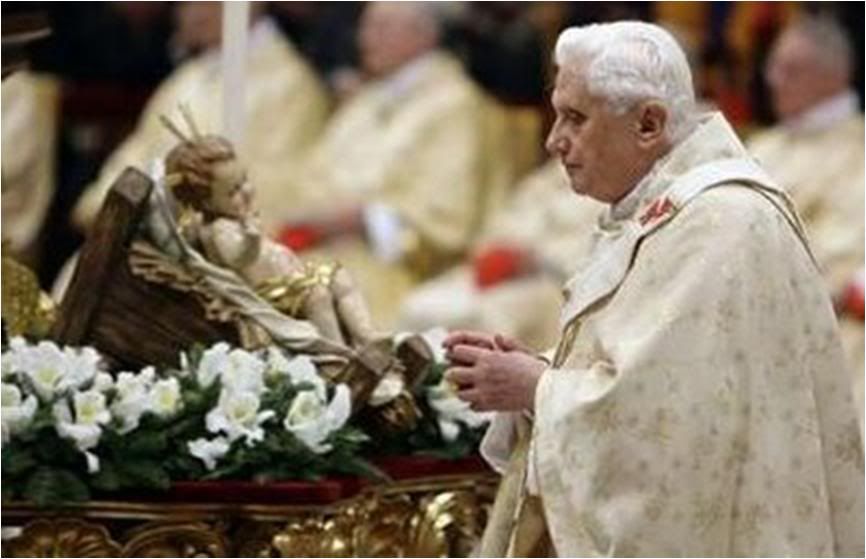 The Holy Father at Christmas Eve Mass, 2008.
The Holy Father at Christmas Eve Mass, 2008.
Liturgical celebrations are able to transmit the joyful news of the faith through words, gestures, silences, symbols, music, singing, the rite as a whole.
What is important is that the rite shines forth luminously and is capable of expressing what it contains.
It is not about making new things, but about making new what the Church asks to fulfilled in the rite.
In the Vatican Basilica this year, the wooden polychrome statue showing the Virgin on a throne with the Infant Jesus giving a blessing, has been installed next to the Altar of the Confession starting with the first Vespers of Advent, and will stay there until Epiphany, to underscore that even Advent and the Christmas season are also Marian seasons.
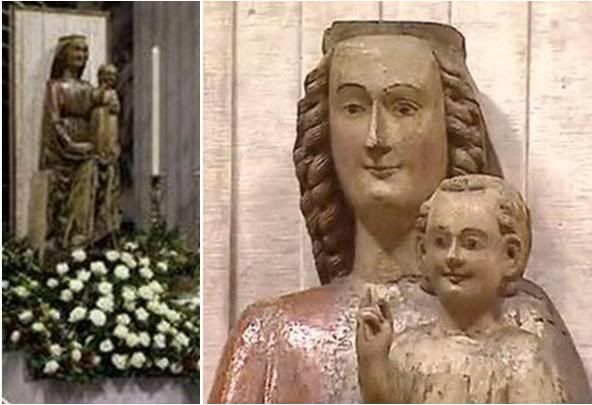
The image belongs to the Umbro-Lazial school of the first half of tHE 14th century. It has been in the Vatican since 1967, and under the responsibility of the Vatican Museums since 1978. It is missing the crown on the Virgin's head. The statue is hollow, so it is presumed it used to be carried in procession.
As has now become usual in papal liturgies, every celebration is preceded by a time of preparation. About 15-20 minutes before the start of the actual rite, readings from various texts and musical passages help prepare the spirit of those present for prayer and meditation. The texts are largely taken from Benedict XVI's homilies in the past year. Then there is a prayer of preparation which is taken from prayers that are part of Church tradition.
The librettos also provide, among the rubrics for the rite, indications for the brief silences after the Pope's homily and after Communion. These are pauses that help the Massgoer to pray and meditate - above all, to assimilate the gift of the Word of God that has been heard, or the Eucharist that one has just received.
The languages chosen for the readings and for the intentions expressed in the prayer of the faithful underscore the participation in the papal liturgy of people coming from different parts of the world. Everyone can listen and pray in their own language, just as in the other parts of the Mass, everyone listens and prays in Latin, the language of the Church, which expresses its unity and catholicity, despite diversity of origins.
In some circumstances, when concelebration is not intended, then there will be two cardinal deacons assisting the Pope. Historically, papal deacons guaranteed administration of the city of Rome and liturgical service to the Pope.
Therefore, this is a historical and liturgical tradition that is proper to the Pope and papal liturgy. In terms of vestments, the cardinal deacons use the dalmatic when they serve the Pontiff. Moreover, they do not concelebrate the Mass, which is an exterior manifestation of their function as servants and collaborators.
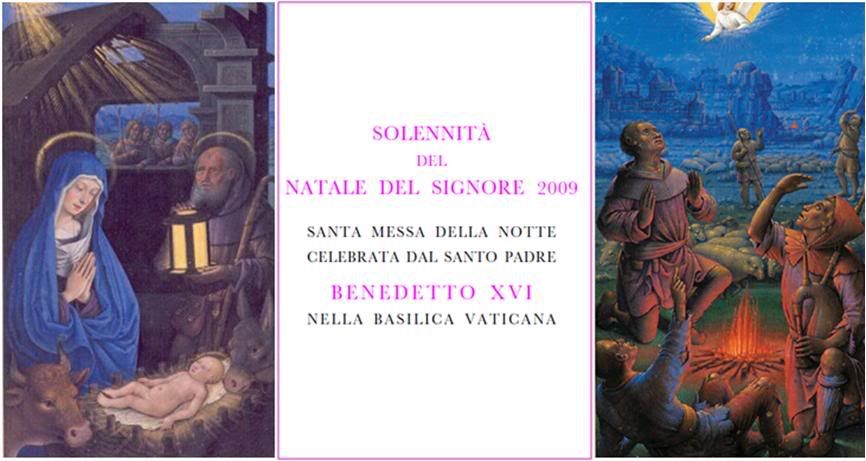
On Christmas Eve, as in previous years, there will be a brief vigil in preparation for the Mass. Last year, for the first time, the Vigil was enhanced with the chanting of the Kalenda, which is no longer sung within the Christmas Eve Mass as before.
The Roman Martyrology provides for it to be sung in the daytime on Christmas Eve, after Lauds or during a minor hour of the Liturgy of the Hours. In this sense, placing the Kalenda at the end of the prayer vigil seems to be more appropriate to its nature.
For the same reason, when the Gloria is sung, right after the Pope intones it, the bells will ring, accompanied by organ music.
Also since last year, the floral tribute by the children to the Infant Jesus now comes at the end of the Eucharistic celebration, when the Holy Father brings the Baby Jesus to lay it down on the manger.
The liturgical attendants for the Christmas Eve Mass will be seminarians of the Legion of Christ.
On Christmas Day, just like last year, the Pope will not wear a cope when he delivers the Urbi et Orbi message. He will be in choir dress, with mozzetta and stole, since this involves a solemn benediction that is not part of a liturgical rite. Serving him will be two students from the Collegio Mater Ecclesiae.
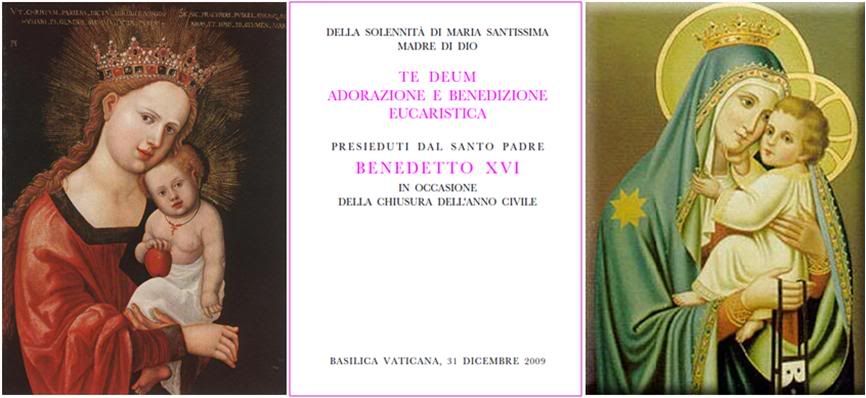
On Dec. 31, eve of the Solemnity of Mary the Mother of God, the Pope will preside at Vespers, followed by the Exposition of the Blessed Sacrament, a Te Deum of thanksgiving, and a Eucharistic Benediction, to signify the centrality of adoration in the life of the Church and the disciples of the Lord, and to accompany the start of the New Year with the blessing of the Lord. Assisting in this service will be students of the Congregazione San Michele Arcangelo.

In the Mass of the Solemnity itself on New Year's Day, the prayers of the faithful will be inspired by the Pope's message for the World Day of Peace, celebrated on that day. Passages from the message are printed at the start of the libretto and will be read during the preparation before the Mass, along with St. Bernard's famous prayer to the Virgin, the Memorare.
Some children and adults from Lebanon will take part in the offering of gifts and in the reading of intentions in the prayers for the faithful.
At the end of the Mass, Benedict XVI will venerate the image of the Madonna. Assisting in these services will be students of St. Mark's Seminary in Erie, New York.
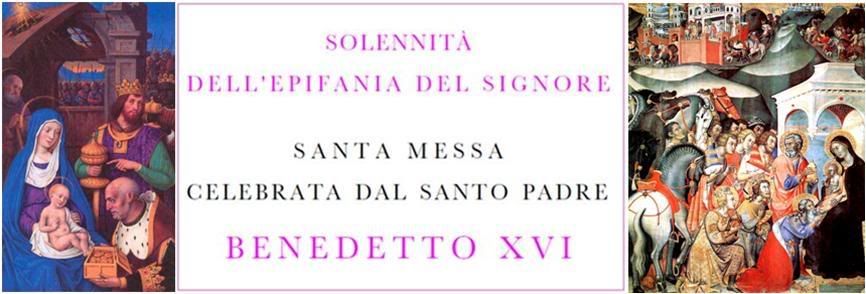
On the Feast of the Epiphany (Jan. 6), the Pope will wear a Roman chasuble instead of the post-Conciliar flowing chasuble, to underscore once more the continuity between past and present, manifested through liturgical vestments.
After the proclamation of the Gospel, the deacon will chant the 'Announcement of Easter'. The Epiphany is a feast of redemption, pointing forward to the fullness of God's manifestation which will take place in the events of Easter.
In this sense, the Epiphany of the Magi is seen as the first act of epiphany-manifestations that form the fabric of Christ's entire terrestrial life. He, the light of the world, is the final goal of history, the point of arrival for an exodus in a providential journey of redemption, culminating in his death and resurrection,
That is why the liturgy of the Epiphany includes an announcement of Easter. The liturgical year summarizes the entire trajectory of the history of salvation, in the center of which is the triduum of the Lord who is crucified, buried and resurrected.
The Epiphany service will be assisted by the students of the Propaganda Fide College.

Finally, for the Feast of the Lord's Baptism, on Sunday, January 10, 14 babies will receive the sacrament from the Pope. For the fourth time in his Pontificate, Benedict XVI will administer the first sacrament of Christian life in the stupendous setting of the Sistine Chapel.
The babies are children of Vatican employees and will be accompanied by their parents, godfathers and godmothers, and their families. The older siblings of the babies to be baptized will bring the gifts at teh Offertory. Thus, it will be a feast of life and of the family.
The Baptism rite will take place within the Mass that the Pope will celebrate at the built-in altar of the Sistine Chapel, and therefore
ad orientem. This decision was taken two years ago in order to preserve the architectonic harmony of the Sistine Chapel. In the decades after Vatican II, a mobile altar was wheeled into the chapel so that the Mass could be celebrated 'ad populum'.
The babies will be baptized at a metal font sculptured in the time of John Paul II by the Italian Toffetti. The Pope will be using a golden shell to pour the water. The scalloped shell is a symbol of pilgrimage, and therefore, of the journey that the newly baptized will begin as soon as they become part of the Christian community.
Assisting at the service will be students from the Vatican's St. Pius X pre-seminary.
[Modificato da TERESA BENEDETTA 24/12/2009 14:30]